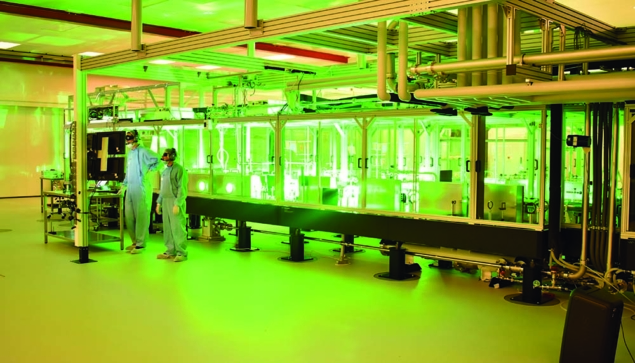
This year’s Nobel Prize in Physics was shared between three researchers for groundbreaking inventions in laser physics. Half the prize went to Arthur Ashkin of Bell Laboratories in the US for his work on optical tweezers, while the other half was awarded jointly to Gérard Mourou of the École Polytechnique in Palaiseau, France, and Donna Strickland of the University of Waterloo in Canada “for their method of generating high-intensity, ultra-short optical pulses”.
Mourou and Strickland’s technique, called chirped-pulse amplification (CPA), opens new perspectives in particle physics. Proposed in 1985, and forming the foundation of Strickland’s doctoral thesis, CPA uses a strongly dispersive medium to temporally stretch (“chirp”) laser pulses to reduce their peak power, then amplifies and, finally, compresses them – boosting the intensity of the output pulse dramatically without damaging the optical medium. The technique underpins today’s high-power lasers and is used worldwide for applications such as eye surgery and micro-machining.
Surfing the waves
But CPA’s potential for particle physics was clear from the beginning. In particular, high-power ultra-short laser pulses can drive advanced plasma-wakefield accelerators in which charged particles are brought to high energies over very short distances by surfing longitudinal plasma waves.
“After we invented laser-wakefield acceleration back in 1979, I was acutely aware that the laser community at that time did not have the specification that we needed to drive wakefields, which needed ultrafast and ultra-intense pulses,” explains Toshi Tajima of the University of California at Irvine, a long-time collaborator of Mourou. Tajima became aware of CPA in 1989 and first met Mourou in 1993 at a workshop at the University of Texas at Austin devoted to the future of accelerator physics upon the demise of the Superconducting Super Collider. “Ever since then, Gérard and I have formed a strong scientific and personal bond to promote ultra-intense lasers and their applications to accelerators and other important societal applications such as medical accelerators, transmutation and intense X-rays,” he says.
Today, acceleration gradients two-to-three orders of magnitude higher than existing radio-frequency (RF) techniques are possible at state-of-the-art laser-driven plasma-wakefield experiments, promising more compact and potentially cheaper particle accelerators. Though not yet able to match the quality and reliability of conventional acceleration techniques, plasma accelerators might one day be able to overcome the limitations of today’s RF technology, thinks Constantin Haefner, program director for advanced photon technologies at Lawrence Livermore National Laboratory in the US. “The race has started,” he says. “The ability to amplify lasers to extreme powers enabled the discovery of new physics, and even more exciting, some of the early envisioned applications such as laser plasma accelerators are on the verge of moving from proof-of-principle to real machines.”
Electrons can also be used to drive plasma accelerators, as is being explored at SLAC and in European labs such as LNF in Italy and DESY in Germany. Meanwhile, the AWAKE experiment at CERN has recently demonstrated the first proton-driven plasma-wakefield acceleration (CERN Courier October 2018 p7). Although AWAKE does not use a laser to drive the plasma, it employs a high-power laser to generate the plasma from a gas, at the same time seeding the proton self-modulation process that allows charged particles to be accelerated. CERN is also a partner in a recent project called the International Coherent Amplification Network, led by Mourou and funded by the European Union, to explore advanced wakefield drivers based on the coherent combination of multiple high-intensity fibre lasers that can run at high repetition rates and efficiencies.
“We have a long way to go, but plasma accelerators have game-changing potential for high-energy physics,” says Wim Leemans, director of the accelerator technology and applied physics division and Berkeley Lab Laser Accelerator Center (BELLA) at Lawrence Berkeley National Laboratory. “Other applications already being explored include free-electron lasers, a quasi-monoenergetic gamma-ray source for nonproliferation and nuclear security purposes, and a miniaturised method for brachytherapy, a cancer-treatment modality in which radiation is delivered directly to the site of a tumour.”
Beyond accelerators, the enormous intensity of single-shot pulses enabled by CPA offer new types of experiments in high-energy physics. In 2005, Mourou initiated the Extreme Light Infrastructure (ELI), nearing completion in the Czech Republic, Hungary and Romania, to explore the use of high-power PW lasers such as Livermore Lab’s HAPLS facility (see image on previous page). Going beyond ELI is the International Center for Zetta- and Exawatt Science and Technology (IZEST), established in France in 2011 to develop and build a community around the emerging field of laser-based particle physics. Under Mourou and Tajima’s direction, IZEST will extend existing laser facilities (such as PETAL at the Megajoule Laser facility in France) to the exa- and zettawatt scale, opening studies including “searches for dark matter and energy and probes of the nonlinearity of the vacuum via zeptosecond dynamical spectroscopy.”





